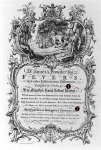Robert James (1703 – 1776)
Of course, quackery wasn’t the exclusive preserve of the Americans as this series, I trust, is amply demonstrating. The latest person to come under our microscope, Robert James, in many ways could be called a pillar of society. He was an eminent English physician, although the level of anatomical and physiological knowledge at the time meant that this wasn’t really a great claim to fame, and a friend of the eminent lexicographer, Samuel Johnson. James was the author of a standard work of reference entitled A Medicinal Dictionary.
But James’ greatest claim to fame was the development of a powder known as Dr James’ fever powder, patented in 1747, and, in accordance with the modesty that goes hand in hand with quackery, was supposed to cure fevers and various other maladies, from gout and scurvy to distemper in cattle. The marketing and sale of panacaeas backed up with implausible claims as to their efficacy was already such a feature of mid 18th century life that the practice was lampooned by the novelist, Henry Fielding, in his novel of 1749, Tom Jones. “As to Squire Western, he was seldom out of the sick-room, unless when he was engaged either in the field or over his bottle. Nay, he would sometimes retire hither to take his beer, and it was not without difficulty that he was prevented from forcing Jones to take his beer too: for no quack ever held his nostrum to be a more general panacea than he did this; which, he said, had more virtue in it than was in all the quack physic in an apothecary’s shop”. Is it too fanciful to suppose that Fielding had Robert James in his sights when he wrote that passage?
The powder attracted a cast of illustrious users, including George III who was prescribed it when he was suffering from cataracts, rheumatism and dementia towards the end of his life, the novelist, poet and playwright, Oliver Goldsmith, and the politician, Horace Walpole. Indeed, so taken was Goldsmith of the powder that the heroine’s father in his book Goody Two-shoes dies when he is seized with a violent fever in a place where Dr James’ Powder was not to be had.
Of course the burning question was what was in the powder. James caused consternation by applying for a patent – it wasn’t the done thing in those days for a gentleman to sully their hands in matters mercantile in this way – and endured further criticism by falsifying the list of ingredients in the patent application on the grounds that he didn’t want his competitors to replicate his powder.
After James’ death scientists sought to establish the ingredients and George Pearson in 1791 determined that it was a mix of antimony and calcium phosphate. Of course, antimony is a toxic substance and regular exposure to the powders is likely to have done more harm than good. Some attribute antimony poisoning as a major contributor to the early demise of Goldsmith. Notwithstanding concerns about the safety of its ingredients and there being no obvious and incontrovertible proof of its efficacy, the powder was used until well into the 20th century.
One other feature of note about the powder was that it was one of the first medicines to be distributed in a multi-dose bottle.
